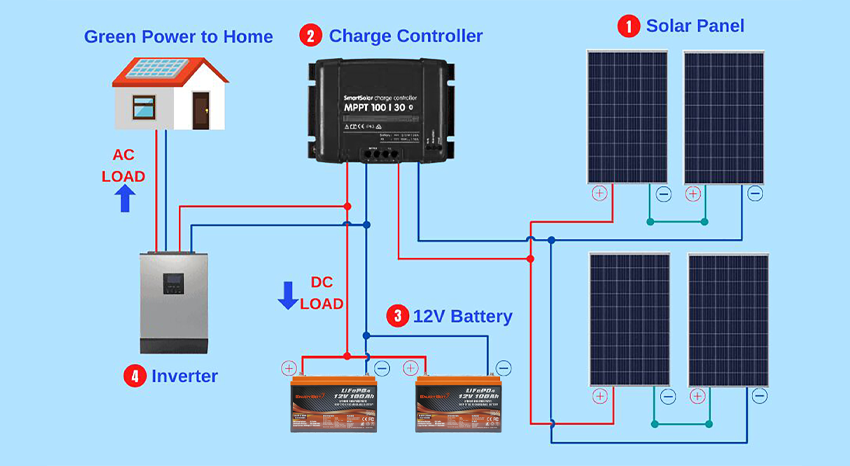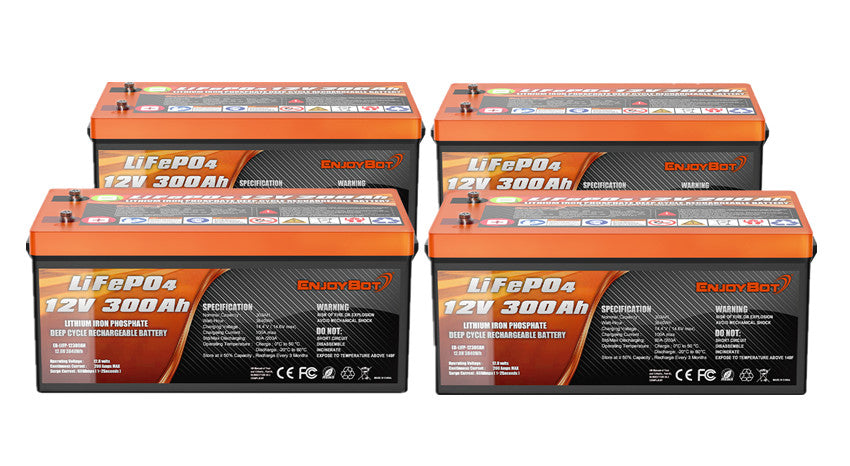The Components of an Off-Grid Solar System

The Components of an Off-Grid Solar System
There is been a tremendous boom in off-grid solar systems in recent years.
Overall speaking, the off-grid solar sector is a whopping $1.75 billion annual market with over 420 million users. This green energy industry shows no sign of slowing down anytime soon. This boom is due in part to the large numbers of people who have been affected by natural disasters, and power outages, as well as people who have chosen to live off grid for environmental purposes.
Whether people are looking to eliminate their power bill or avoid weather blackouts, off-grid solar systems are a great answer. If you are looking to join the millions of people embracing solar energy, it will be helpful for you to understand what the major components of these systems are. Let’s go to check this out. In this blog, you will learn more knowledge about Off-Grid Solar systems.
What is an Off-Grid Solar System?
The off-grid solar system uses green energy from the sun to meet all of your power needs without connecting to the power grid.
Off-grid solar systems are becoming increasingly popular for those people who are looking to minimize their environmental impact and reduce monthly expenses. They are also an excellent option for RVers and those looking to camp or adventure outside of established campgrounds. Boaters enjoy having reliable power when they are go out on the water and disconnected from shore power. It can be a new way of life that allows you to be less dependent on other people.
Building an Off-Grid Solar System
While solar panels are the most visible part of an off-grid solar system, they are just one part of the whole system. You will also need a solar charge controller to convert the energy, batteries banks to store the power, and an inverter to use the energy. These are all important components of a solar system that operates completely off the grid.
A typical off-grid solar system utilizes solar panels to capture the energy from the sun and convert it to green electricity. However, without proper conditioning, the electricity from the solar panels could damage the storage batteries.
If you are building an off-grid solar system, a solar charge controller regulates the voltage and current from the solar panels to safely store in a battery bank. The voltage of a typical battery is 12 volts DC (direct current). This is adequate with low-power devices, but for high-power devices, you will need high-power AC (alternating current).
If you are using batteries to power lights and appliances, then one or more deep-cycle batteries are needed. You will also need one or more inverters to transform the direct current from the batteries into alternating current for home use. The inverter then feeds AC power to the electrical outlets. Head over here for information about the best deep cycle battery for your needs.
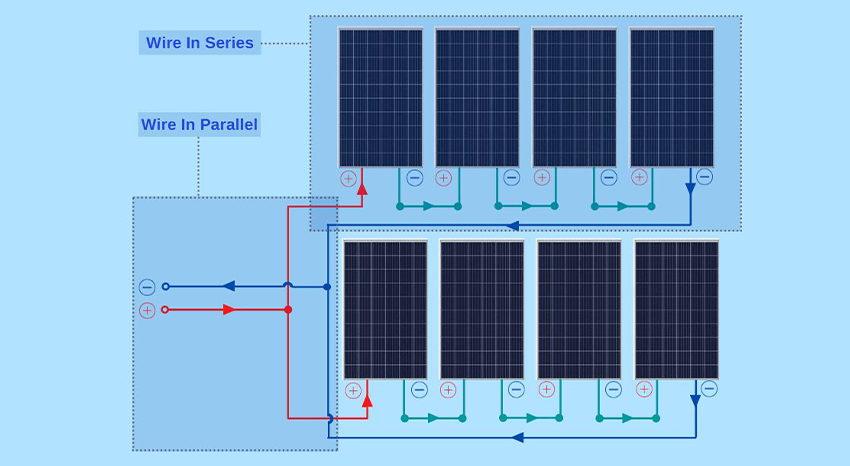
Solar Panels
The solar panels you see mounted on homes, businesses, boats or RVs consist of many small photovoltaic cells. The photovoltaic cells are made of a semiconductor material that captures sunlight and converts it into electricity.
There are several types of solar panel options to consider when you are creating off-grid solar systems.
Thin-film and semi-flexible solar panels are light weight and great options for RVs and marine surfaces that are typically not flat. Usually, the flexibility of these panels enables them to conform to the curves on many boats and RVs. Additionally, these solar panels can weigh less than 40 pounds (18 kilograms) which makes them less susceptible to theft or damage. They are portable and flexible options but often offer lower efficiency and performance than other solar panels.
Multicrystalline and monocrystalline are other options to consider when looking at solar panels for your systems. They are similar in construction, but typically, monocrystalline solar panels are more efficient. However, a monocrystalline solar panel is typically more expensive than a multi-crystalline panel. These are great options for residential or flat surfaces, whether it is a roof or a mounting bracket in an open field or grass area.
Monocrystalline panels are the most expensive and most efficient solar panels available in the market. Typically, these solar panels are more efficient in warm weather and also in low-light conditions. If you are planning to look to maximize your off-grid capabilities and efficiency, the monocrystalline solar panels will likely be your best choice.
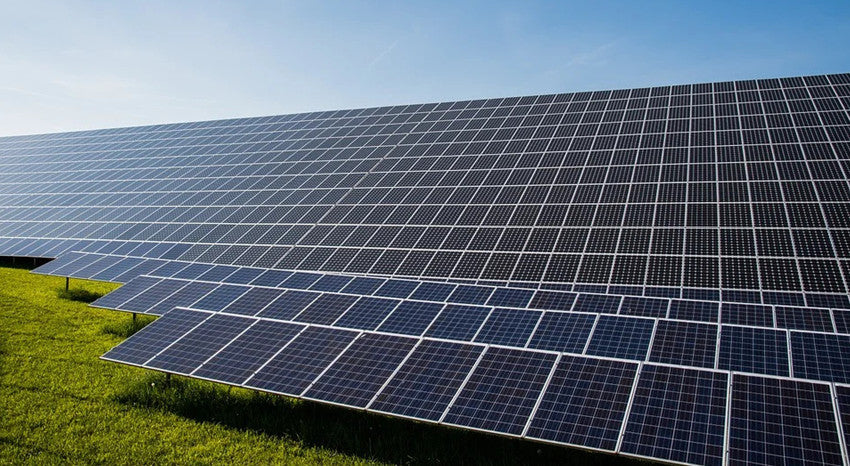
Solar Charge Controller
The solar charge controller is another essential component of any off-grid solar system. The solar charge controller manages the power from the solar panels going to the batteries banks. It can be used to prevent overcharging of the battery bank to regulate the battery bank voltages. It can also be used for both short circuits and temperature protection.
The charge controller helps to ensure batteries do not overcharge during the day and that at night, energy power does not flow backward from the batteries to the solar panels. MPPT charge controllers are the charge controller of the best choice for most solar systems. The MPPT charge controllers are more expensive than their Pulse Width Modulation (PWM) counterparts. However, MPPT charge controllers are far more efficient and worth the investment.
Off-Grid Power Inverter
Another essential component of your solar system is the power inverter, which will manage the flow of AC and DC power. Your battery bank stores DC power, but many of your house appliances and electronics require AC power. So the power inverter turns DC power to AC power.
It is important to buy a proper size inverter for your needs. An inverter is sized by its power capacity, measured in watts. You can easily estimate the inverter size your electronics and appliances need. You can through adding up the power requirements (in watts) of all of your electronics and house appliances. It will tell you how big of an inverter you need.
For example, if you are planning to connect a 1,500 watts microwave, 200 watts of lights, and a 400 watts fridge to your inverter, we recommend a 3,000 watts (3 kW) inverter.

The Battery Bank
The Most Important Part of an Off-Grid Solar Setup is the battery bank.
A battery bank is simply multiple batteries connected in series or parallels. Batteries are where power energy from the solar panels is stored.
Without the storage batteries, you would only be able to use the off-grid solar system during the day, assuming it is a sunny day. Having reliable and adequately sized batteries allow you to utilize the off-grid solar system day or night, rain or shine.
Lead-Acid Batteries
The deep-cycle lead-acid battery has been the most common and readily available battery option for cars, RVs, Vans, marine, fishing boats, and solar applications for many years. Lead-acid batteries typically have a low energy density, moderate efficiency, short lifespan, and high maintenance requirements.
Pros
The main benefit of the lead-acid battery is the low upfront cost. A typical lead-acid battery will cost somewhere around $100-$350.
Cons
Although the lead-acid battery is the most popular battery for rechargeable and starting applications, it has a long list of negative qualities. Lead-acid batteries are incredibly heavy, have a short lifespan, and require frequent maintenance. If you are draining lead-acid batteries below 50% of their rated capacity will cause permanent damage and decrease the already short life of the battery.
Lithium Iron Phosphate (LiFePO4)Batteries
One of the growing trends in off-grid solar power systems is using deep cycle lithium iron phosphate (LiFePO4) batteries for the battery bank. LiFePO4 batteries used lithium salt to create efficient and lightweight green energy storage.
Pros
There are plenty of reasons people are making the switch to LiFePO4 batteries. For one, LiFePO4 batteries are more efficient and charge faster than traditional lead-acid batteries. Additionally, you can use more than 80% of the rated capacity of a LiFePO4 battery without causing damage. On top of that, LiFePO4 batteries weigh about half of what their lead-acid batteries' counterparts do. However, one of the most popular reasons people love the LiFePO4 batteries is that they don't need to maintain and easily last ten years or more. Today, more and more people switched their lead-acid batteries to LiFePO4 batteries.
Cons
Despite the long list of pros, LiFePO4 batteries are not perfect. The main drawback is that they are too expensive upfront cost. While a lead-acid battery can be $100-$350, a comparable LiFePO4 battery will typically cost $400-$1,200. Despite being cheaper in the long run, this massive upfront cost is often a deterrent to many people.

How Much Does An Off-Grid Solar System Cost?
The cost of an off-grid solar system varies depending on how much electricity a home appliance uses and the size of the system you choose. A small setup for a weekend of RVs or camping with 100W solar panels and a 100Ah battery will run you a few hundred dollars, depending on which battery you choose. This energy system will be enough to keep some small electronics and lights up and running and require minimal installation. This system will run you $400-1000, which is money well spent to get rid of your electric utility bill for good (saving you $250-$350 per year).
If you are planning to purchase a medium-sized setup for a cabin or more extensive camping, you will likely need about 1,000 watts of solar panels, a 3,000-watt inverter, and a 400 Ah batteries bank. This system will likely require a professional installer unless you are handy with electricity.
The price of this system also varies depending on if you are using LiFePO4 or lead-acid batteries. For comparison, 400 Ah of lead-acid batteries could cost as much as a single LiFePO4 battery. A typical setup of this caliber could cost approximately $5,000-$10,000.
If you are looking to live completely off-grid in a residential home, you are looking at a pretty significant investment. The average solar system is between 12 and 20 kW, but that depends on your individual electricity needs. A 12,000-watt of a solar panel is enough to power most homes in the U.S., this system needs multiple 5,000-watt inverters to change DC power into AC, and a 1,000 to 1,200 Ah battery bank that stores excess energy during the day.
These systems will typically cost upwards of $25,000+ and the constructions are more complex. Unless you have professional training or experience, it is best to leave this one to a professional engineer.

Other Off-Grid Solar System Equipment Needed
We have covered the major components of an off-grid system, but you still need more components to complete your setup for your solar system. For example, a battery monitor, wiring, fuses, and distribution bars are just a few of the other components required to make your system work correctly. Especially, the battery monitor will let you know the exact charge capacity of your batteries, so you know exactly when it’s time to replace them. The fuses and distribution bars will protect your appliances from getting blown away in a power surge.
It is necessary to ensure each of the components in your system is rated for the size and demand of your system. You need to make sure that your home's electrical system can handle your home appliances. Having underrated components can be dangerous and pose a fire risk. If you are unfamiliar with any of these components, please be sure to ask the help of experienced and trained professionals.
Disconnect and Self-Sustain By Going Off-Grid
An off-grid solar system is the greatest way to disconnect and be self-reliant.
This solar energy system has low-cost effective, reliable, and requires practically no management, while using the most tried-and-true renewable green energy source we have--the sun. They can also save homeowners thousands of dollars per year on energy bills.
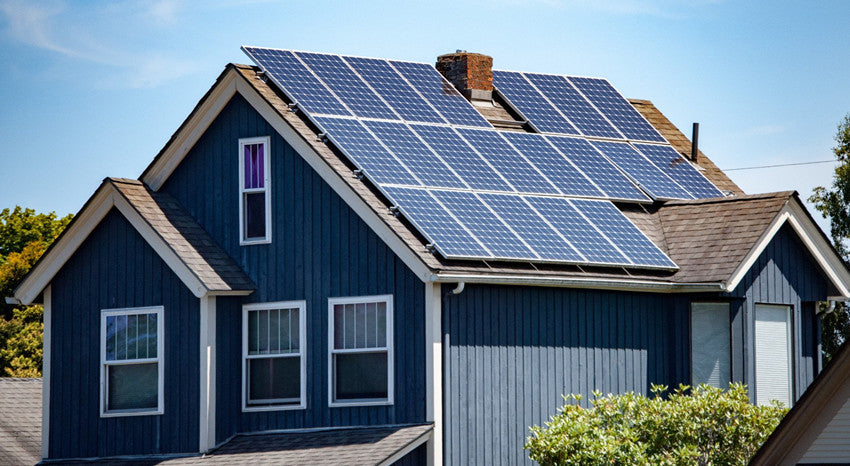
Solar Panels on Side of the Cabin
Off-grid solar systems are often used to serve as a backup in power outages, or supplement traditional power systems.
How many units of solar panels does it take to run a house off-grid?
Let's assume that we have 300 watts solar panels, and you are planning to provide power for your off-grid home. You do not have access to the grid and installing off-grid solar on your home is your best option for meeting your energy needs.
Let’s assume that each panel gets around eight hours of sunlight per day. A 300-watt panel receives eight hours of sunlight per day that will produce almost 2.5 kilowatt-hours per day. If we multiply this by 365 days per year, we will get a solar output of around 900 kilowatt-hours annually. In short, each solar panel will provides 900 kilowatt-hours per year.
How much energy does your home use?
Most data shows that a typical American home ( 2,000 square feet home ) consumes approximately 11,000 kilowatt-hours annually. So, we can divide our total consumption by the expected output of a 300W solar panel, we will see that roughly 13 solar panels of this size would be enough to power homes of that size. The next step is to figure out how many solar panels you should mount based on the amount of sun you receive where you live.

12V, 24V, OR 48V? WHICH IS BEST?
Usually, people all know that panels and inverters typically come in either 12, 24, or 48-volt options. The RVs and boats commonly use 12v batteries, so people like a stick with 12v solar panels. A 12-volt system used to be the standard for most American homes, but today, many larger home systems are rated at 24v or 48v.
12v systems are good for many DIY solar scenarios, including RVs/motor-homes/vans, camper trailers, and small cabins or tiny homes. If your power energy needs are about 1,000 - 5,000 watts, a 24-volt system is best for you. If your power energy needs are over 3,000 watts, consider the 48-volt system. Today, large off-grid houses often use 48-volt systems.
Is an off-grid solar system worth it?
Going Off-Grid Makes Financial and Environmental Sense in the Long Run.
The initial costs are high but you can recoup the original investment in as little as 3-5 years, and after that, you will reap the benefits for decades. Your investment on the battery systems that will be used to store solar energy will take longer to recoup, though; the payback periods for battery systems usually last 10 years if you are using LiFePO4 batteries as your storage system.

How many units of solar panels do I need to run a refrigerator?
Different-sized refrigerators have different wattage. But the calculation is the same for every household appliance.
How Many Watts Do the Solar Panels Produce?
The amount of solar power your solar panels produce depends on several factors, such as the panels themselves, the weather, and your setup. If the average residential solar panel produces 250 watts during peak production, or a solar panel produces 250 watts for four hours a day, it equates to 1 kWh. (250 x 4 ÷ 1000)
Determine How Many Watts Your Refrigerator Uses
Every refrigerator has an energy rating sticker on it which estimates the average kWh per year the fridge uses. Now that you know how much energy your solar panels produce and how much power your refrigerator needs, the rest is easy. You can divide the energy required by the energy produced, and the result is the number of solar panels you need. For example, if your fridge uses 2 kWh per day, and your solar panel produces 1 kWh per day 2 ÷ 1 = 2, so you need 2 solar panels to power your fridge.
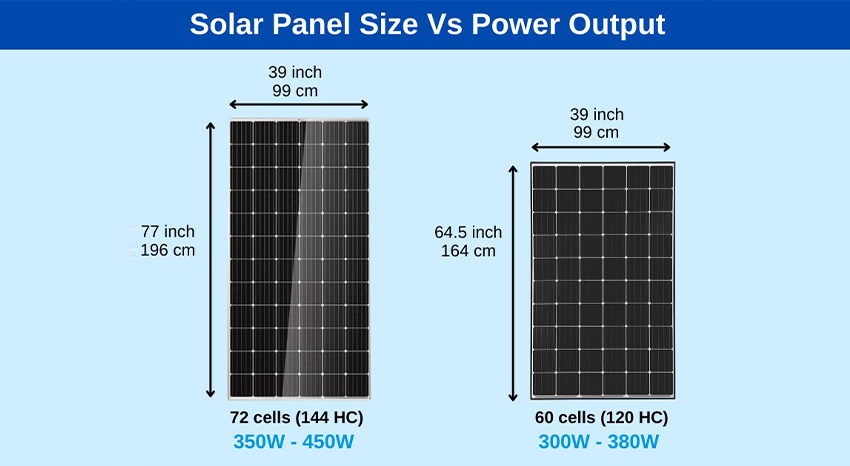
How long does it take 100 watts solar panel to charge a battery?
This is depending on a variety of factors, such as the size of your battery, the efficiency of your solar panel, and the amount of sunlight available.
You should confirm the following information before charging batteries with solar panels.
What is the battery's capacity when fully charged?
The battery's depth of discharge in regular operation.
Irradiance in your location (If not known, use 4 peak sun hours as an average value.) The type of solar controller to be used (MPPT is more efficient. )
Generally, a typical size 12v 50Ah auto battery at 20% discharge will need 2 hours to fully recharge with a 100-watt solar panel.
A lead-acid deep-cycle 12v 50Ah battery at 50% discharge will take around 4 hours to fully recharge using a 100-watt solar panel.
The above examples assume a solar panel current output of 5.75 amps using an MPPT controller.
How long does it take a 100 watt solar panel to charge a 100 amp battery?
A 100W-rated solar panel using an MPPT solar charge controller will take approximately 12.5 hours to fully recharge a 50% discharged 100Ah lead-acid deep-cycle battery. 200 watts of solar panels is recommended to recharge a 100Ah battery in one day if the battery is used for home energy storage.
If a 100-watt solar panel connects with an MPPT solar charger, it will take about 20 hours to fully recharge an 80% discharged 100Ah lithium iron phosphate (LiFePO4 ) battery. 250 watts of solar panels is recommended to fully recharge a 100Ah LiFePO4 battery in a day if this battery is to be used for home energy storage.

Conclusion
More and more Americans are switching to solar power, due to a combination of decreasing costs, tariff exemptions, improved technology and, of course, the alarm bells going off about climate change. You might have noticed that more solar panels go up around your neighborhoods or businesses in your area announcing that they are switching to renewable green energy — it is all part of a worldwide effort to reduce greenhouse gas emissions by 2030 in order to prevent a catastrophic increase in the global temperature. All in all, it is an exciting time for all things solar.














